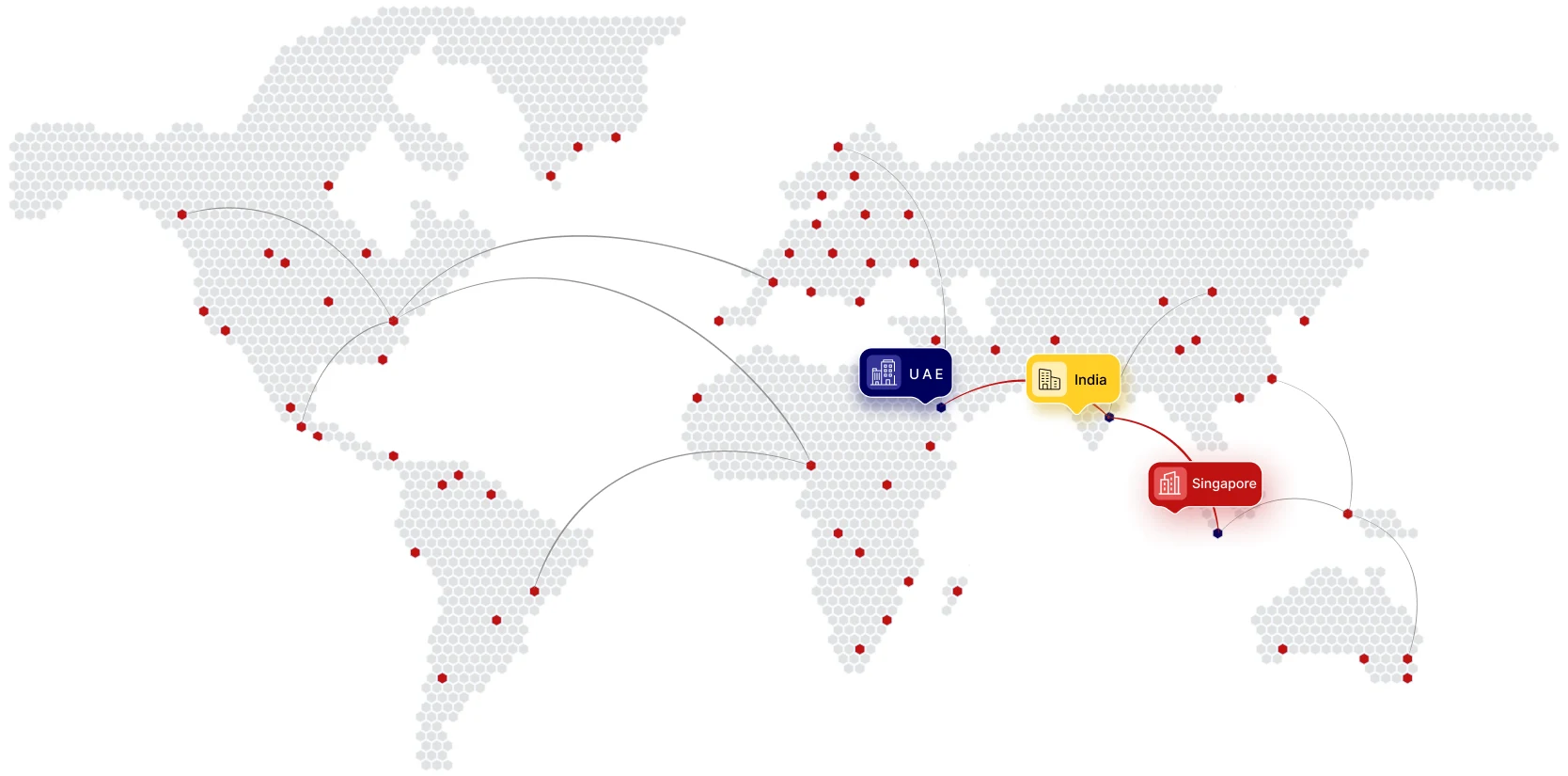
- Article
- September 7, 2021
What is RPA?
RPA doesn’t involve any physical robot. It essentially employs software robots running on a computer to automate repeatable high volume business processes. Mostly structured data are worked upon by combining artificial intelligence including machine learning, natural language processing etc.
We can define a set of instructions and enable RPA bots to mimic most of our interactions with computers for carrying out high volume error-free tasks with incredible speed and accuracy.
Why is RPA different from AI?
Most of us with a non-technical background seemingly baffled by these two words and their respective uses. Simply put RPA can deal with only structured data while AI due to its inherent intelligence can deal with unstructured data too. RPA technologies and applications haven’t become all that intelligent up till now.
Repetitive and rule-based tasks needing much manual effort can be easily handled by RPA however without any neural network providing intelligence gathering with experience. As a result, any changes in automation will go unnoticed by an RPA bot without detecting anything on its own. In an F&A context, when the legitimacy of business expenses can be validated by AI, RPA can’t just decide if a business expense on personal and family entertainment can be approved or not.
Why has Digitization and RPA become so critical as never before?
The last year has witnessed widespread financial disruptions for most of the companies due to pandemic when only technology and digitalisation stood by them as their saviours.
RPA as a recession-proof saviour for business continuity has become critical for business survival and growth. Automation driven by smart technologies e.g.ML and AI is enabling more robust and cheaper business solutions across all industries.
More F&A professionals are seeking RPA implementation and creating new business codes. Remote working as a new norm has heightened the need for greater operational flexibility coupled with higher capacity.
The world has now seen more digital transformation in the last few months than in the preceding decade, with more than 70% of global businesses planning to switch over to RPA and increase RPA spending soon.
As economic regrowth continues to hurt all businesses, organisations are reassessing integrating RPA in F&B functions and promoting automation to establish a cost-effective resilient work culture.
What are the benefits of implementing RPA in F&A?
Several opportunities exist for RPA to realize a competitive advantage and include
- Cost savings in many geographies as robots cost much less, 10 to 20% of the cost of a full-time employee.
- RPA can accomplish very high data accuracy consistently.
- Can achieve reduced transaction times and improve efficiency.
- Can work 24/7/365 and result in high FTE.
- Cycle times can be reduced drastically improving throughput.
- Can reduce employee attrition because of reduced frustration caused by repetitive draining daily tasks.
- High speed achieved by RPA can help maintain deadlines during the financial year-end.
- RPA being much flexible and scalable can put a significant brake on unnecessary cost escalation.
What are the areas of RPA applications in F&A?
Following are some areas where RPA can be implemented effectively for organizational growth and sustainability
- Bookkeeping
- Accounts Payable and Receivable
- Invoicing
- Vendor data management
- Days sales outstanding
- Logistics management
- Client Onboarding
- Reconciliations
- Expense monitoring and management
- Inventory management
- Payroll
- Tax compliance and reporting
What F&A tasks cannot be performed by RPA?
Not every F&A task can come under RPA and tasks usually not suitable for RPA include:
- Complicated tasks such as allocating funds, performing due diligence etc.
- Decision-making non-standard processes
- Infrequent and uncertain processes
- Processes needing improvements and streamlining
- Processes with too many exceptions
How to implement RPA effectively in F&A?
Most RPA implementations are normally easy and straightforward, not requiring more than 3 months to identify processes, configure framework, validate and launch RPA bots into operations.
Below is a deployment guideline for effective use of RPA in F&A
- Identifying high volume, error-prone and repetitive processes with a significant impact on both cost and revenue
- Selecting sub-processes that can be easily automated with RPA e.g. standard processes with few exceptions
- Selling ideas to top management and F&A team members with an approximate budget
- Taking other business process owners in confidence
- Fragmenting the F&A process into the sub and sub-sub processes to better understand the process flow
- Considering improvement possibilities with ROI
- Selecting a dedicated team to work on the project
- Exploring and developing ways for RPA implementation and assessing benefits and challenges
- Running a real-life test
- Validating through repetitive tests
- Launching and going live
- Ensuring post RPA maintenance after launch
What are the challenges in implementing RPA?
RPA implementation challenges can be rather serious unless strategic thoughts and proactive actions are not planned religiously.
RPA is high-tech and needs skill and expertise in technology besides accounting knowledge. The non-availability of the right human resources is often a big challenge for effective implementation.
There are processes with exceptions needing separate ML algorithms that can increase the cost of implementation.
RPA implementation needs a cultural shift in an organisation and is always a serious challenge for a company due to the fear of redundancy amongst employees.
Choosing the wrong accounting process for RPA is a common mistake resulting in poor ROI and increased cost.
Proven validated practices are not known and followed causing huge wastage of time in debugging.
Many companies don’t have sound IT and security policies. F&A professionals working upon RPA implementation in pockets may cause serious adverse implications for IT security, infrastructure and the entire business as a whole.
Maintenance is vital to keep your RPA running and achieving desired process efficiency. It is usually observed that post-implementation protocols are missing due to inadequate IT infrastructure, offering challenges to the organisation.
How can F & A outsourcing facilitate RPA implementation?
You can put aside a lot of headaches by outsourcing F&A for a smoother RPA transition. There are several reasons businesses outsource their finance and accounting functions and RPA implementation and a few of those are
- There is no need to sell your ideas for RPA implementation to inhouse F&A professionals
- Accessibility to skilled manpower as technology-savvy accountants familiar with RPA implementation is hard to find for the in-house accounting team
- The outsourcing companies performing F&A functions as their core competency do invest heavily in ‘best practice processes, employee training and sophisticated technologies and software which are normally out of reach for most of the businesses in the SME sector
- As outsourcing companies are committed to a much higher level of accounting performance, they continuously keep themselves updated on the latest technologies and RPA opportunities
- During unforeseen and trying business times as with covid pandemic, outsourcing can offer increased RPA transition and ROI by avoiding the wrong selection of processes for automation
- Last but not least, outsourcing can reduce RPA implementation cost by more than 50%
- Continuous training of internal employees on RPA
Conclusion
RPA is going to stay and as RPA adoption by companies surges, the need for standard processes has become paramount. We humans, previously busy in routine manual tasks, must now concentrate more on managing exceptions for ensuring RPA implementation on a higher scale encompassing many more aspects of finance and accounting.
As an outsourced accounting and financial services provider, IMC commits itself for robust RPA implementation well considering all implications on existing operating models and continuously exploring ways to effectively adapt to the changing requirements of its customers.
As expertise, experience, strategic planning and vision are indispensable in leveraging the benefits of RPA, we at IMC would like to provide our best professional support and enter into discussions on your journey towards RPA implementation.

- Article, Singapore
- August 31, 2021
Introduction
Banking is considered the backbone of every economy as it directly influences the
financial and economic development of a country and Singapore is no exception. The country’s robust economic development gathered pace as the banking sector grew and became stronger and efficient with time. The importance of the banking sector is equally recognised both in the developed and emerging economies.
Today’s Singapore is the top international financing hub in Southeast Asia, believing and implementing pro-business government policies and practices. Its strategic location as the gateway to the ASEAN coupled with its favourable policies has transformed this country into a banking hub in the region.
The total assets of the banking sector in Singapore is worth more than USD 2 trillion with over 200 banks operating in Singapore.
What is the Monetary Authority of Singapore and what role it played in the Banking Industry?
As the number of domestic financial institutions started growing rapidly along with the entry of foreign financial companies, the financial services sector in Singapore became more complex necessitating the need for better and more cohesive governance and regulatory approach. The Monetary Authority of Singapore was then established in 1971 to address this issue and played the dual roles of a central bank and the financial regulator.
MAS is the regulatory body for financial institutions in the banking, capital markets, insurance and payments sectors and formulated, implements and administers regulations and licensing requirements for these sectors.
More details about the financial institutions under MAS’s regulation and their authorised and regulated activities can be obtained from the Financial Institutions Directory provided in this link.
The Monetary Authority acts as an existing central bank in Singapore with its main function to ensure effective and smooth operations of financial institutions in perfect alignment with the national economic objective. The MAS is responsible for the following:
- Monetary policy implementation
- Banking systems supervisions
- Functioning as the banker to the government and the banks
- Controlling foreign exchange reserves
- Printing and Issuance of currency
- Issuing banking licences
What are the reasons for the thriving banking industry in Singapore?
Following are a few factors that contributed to the thriving banking industry in Singapore today.
- Liberalisation of local banks
- Expansion of overseas banks
- M&A of foreign and local banks
- Increased competitiveness for pricing and innovative services
- Investment banking and wealth management services
- Government policies of Tax and Secrecy rules
- The phenomenal growth in the number of SMEs
How has the Singapore Banking industry been liberalized over the years?
The significant milestones in the development of Singapore’s banking industry are enumerated herewith in chronological order
- 1999 to 2001, Liberalisation of the banking sector with a five-year liberalisation package with Qualifying Full Bank (QFB) licensing of foreign banks with an increased number of places of business and removal of 40 per cent foreign shareholding limit in local banks was lifted
- 2001 marked the second phase of measures granting 20 Restricted Bank licenses over the two years for freeing up competition in the wholesale banking business with a bigger business domain, the restricted banks were re-classified as ‘wholesale banks’ to upgrade all offshore banks to wholesale banks over time
- 2005, MAS increased the number of places of business for QFBs from 15 to 25
- 2012, MAS further increased the privileges of QFBs to 50 places of business and introduced Significantly Rooted Foreign Bank (SRFB) framework for the domestic market and depositor protection
- 2018, introduction of Fast and Secure Transfers (FAST) networks for allowing access to NBFCs
- 2019, issuance of 5 digital bank licences, 2 digital full banks and 3 digital wholesale banks
Why has the private banking industry grown significantly in Singapore?
The reasons for the private banking industry growth are
- Increased number of HNIs in Asia
- Banking secrecy policies
- Value-added banking services including wealth and lifestyle advisory services, investment strategies, asset protection etc.
- High banking standard
- Vibrant and growing capital market
- Expensive banking activities
What is SME Banking Services in Singapore?
SMEs contribute significantly to Singapore’s GDP and both local and foreign banks offer financial services to these enterprises including trade financing, loans, deposits and insurance. Besides issuing commercial credits, the Singapore government provides various financing schemes to support SMEs in expanding their operations. Maybank, Standard Chartered, City bank, RHB, HSBC and many other banks have SME financing facilities.
What are the different types of Banks in Singapore?
Most of the Singapore banks provide a wide range of banking services to their clients, all corporates, individuals and government agencies including commercial and retail banking, private banking to HNIs etc. There are two types of banks
- Local Banks
- Foreign Banks
- Full banks, Six foreign banks are given QFB status and include HSBC, Citibank, Standard Chartered, Maybank, ABN AMRO and BNP Paribas
- Wholesale Banks offer similar ranges of services except Singapore Dollar retail banking
- Wholesale banks are branches of foreign banks in Singapore and include ING Bank, National Australia Bank, Barclays Bank, Deutsche Bank
- Offshore Banks are also branches of foreign banks and a few of them are Korea Development Bank, Bank of New Zealand, Canadian Imperial Bank of Commerce etc.
- Merchant banks offer specialized services such as corporate finance, underwriting of shares and bonds, mergers and acquisitions, portfolio management, consultancy etc. Credit Suisse Singapore Ltd, Barclays Merchant Bank Singapore Ltd, ANZ Singapore Ltd, Axis Bank Ltd are some of the well-known merchant banks in Singapore
What are the main banks in Singapore?
The three main local banks are
- Development Bank of Singapore
- Oversea Chinese Banking Corporation, OCBC
- United Overseas Bank, UOB
The six main foreign banks in Singapore include
- The Hong Kong and Shanghai Banking Corporation (HSBC) Singapore
- Standard Chartered
- ABN-AMRO Singapore
- Maybank
- BNP Paribas and,
- Citibank
What are the Banking Laws and Regulations in Singapore?
Besides regulatory legislations, the banking laws and regulations in Singapore provide a broad legal framework for the banking industry to remain in conformity with the latest developments and changes in the world’s banking and finance sectors. All banking regulations are passed and approved by the Parliament.
The banking industry acts include the following
- Banking Act – The Banking Act governs commercial banks in Singapore
- Monetary Authority of Singapore Act governs all matters related to and connected to MAS and its operations
- Anti Money Laundering Regulations
- Payment & Settlement Systems Guidelines
- Securities and Futures Act
Conclusion
An economic support package of USD 125 Million has been announced by the MAS for the financial and FinTech sectors to fight against the impending challenges of the covid 19 pandemic and reposition Singapore on a strong foot for immediate recovery and future growth of the banking and financing sector.

- Newsletter, U.A.E
- August 25, 2021
The long-anticipated approval of the UAE cabinet for joining the Madrid Protocol for trademark registration systems has been accorded recently and is likely to come in force by this year-end or early 2022.
To strengthen and promote Intellectual Property Rights, the authorities planned for using the International Madrid Protocol Administrative System that allows filing, registering and maintaining Trademarks in over 120 different member countries. Amongst the GCC nations, only Bahrain and Oman are presently a part of the Madrid Protocol.
The UAE Trademark Office (TMO) will only certify international applications and forward those to the World Intellectual Property Organisation (WIPO) electronically once the Madrid Protocol is enforced in the country.
The WIPO will then carry out the subsequent processes involved including conducting examination, goods or services classification, trademark registration, publishing the trademark in the International Gazette and notification to the designated countries. There is usually a strict deadline given by WIPO within which the member countries of the Madrid Protocol must decide if the international trademark in their territories can be granted.
The International Trademark Registration normally takes around 18 months from the date of notification of the registration subject to no objection from individual designated members. The trademark will then be registered within the territory of that member in the same way as it gets registered directly with the local IP office.
Once the UAE joins the Madrid Protocol, UAE applicants will be allowed to obtain and protect their trademarks around the world through cost-effective and user-friendly procedures for trademark applications and registrations in many countries in a centralized manner.
What is the Madrid Protocol?
The Madrid Protocol is a system of international registration of trademarks that permits the brand owners to apply and maintain protection in 124 countries through one single procedure. The levels of protection, however, can differ in different territories.
The Madrid System for the international registration of trademark rights in multiple jurisdictions is administered by the WIPO headquartered in Geneva.
The registration of Marks under the Madrid Protocol is cost-effective and the application can be done in one language. A cost savings of 30% to 40% may be realized compared to national filings.
What are the Benefits of Madrid Protocols?
The use of the Madrid System for companies with a global presence provides several benefits including
- Cost Savings potential
- The simple and easy filing process
- Streamlined management with centralized filing, registration and maintenance
- Use of one language as per applicant’s choice
- No need for local representatives in individual designated countries
- Easy and less cumbersome documentation with minimum formalities e.g no requirement of POA
- Provision for extension of geographical protection of an international mark as and when necessary for commercial interests, any new jurisdiction can be easily added
- The examination period is fixed and finite either 12 months or 18 months
- The application receives automatic protection whenever there is no objection raised
- Country specific local representatives are not warranted if no objection is raised by national trademark authority or by third parties
- Easy renewal of Trademark
- Easy incorporation of Mark holder’s details
What are the Disadvantages of using the Madrid Protocol?
Though the Madrid Registration system offers multiple benefits, it also comes with its share of anomalies, complications and vulnerabilities, both in terms of the process and the protection offered.
- Can only be extended to the member countries
- As the registration is based on home filing for the initial five years, any cancellation or abandonment of the home filing renders the international registration automatically stands cancelled
- Even if a mark is accepted in the home jurisdiction, it doesn’t necessarily mean that it would be accepted in every designated country in the Madrid registration application due to the non-circumvention of WIPO in local trademark laws
- Response deadlines can be very short posing difficulties in timely action and appointment of local representatives for responding to actions
- The wide variance in application processing time
- Enforcement problems in countries where national trademark laws have not been revised to recognise the international registration system e.g. African continent
- Also, some anomalies exist in certain key territories
What is the Process of Registration of Trademarks under the Madrid Protocol?
The following three important steps are involved in registering a trademark through the Madrid System.
Step 1: Application through Office of origin
An international application needs to be filed, Form MM2 through the “home” IP or Trademark office known as Office of origin, certifying your international application and forward it to WIPO online
Step 2: Examination by WIPO
WIPO carries out a formal examination of the international application and does not refuse or grant trademark protection. WIPO only checks the information provided in international applications. Once the application complies with the requirements of WIPO, the Mark is recorded in the International Register and subsequently published in the WIPO Gazette of International Marks making the applicant the holder of an International Registration.
WIPO then sends a certificate of registration with a notification to the IP Offices in all the territories where the applicant wishes to have the trademark protected and as given in the international application.
Step 3: Substantive examination by national/regional IP offices
Once notification is received from WIPO, the IP offices of the territories where protection is sought conduct a substantive examination of the trademark as per the prevailing trademark laws in those territories. Every individual territory through its IP office decides if the trademark can be protected in that territory or not. It usually takes around 12 to 18 months.
WIPO then sends an intimation informing the decision of the individual territories. In case trademark protection is refused by any territory either totally or partially, this will not affect the decisions of other IP offices.
If trademark protection is accepted by an IP office, it states a grant of protection. The international registration of trademarks bears a validity of 10 years in each designated territory making the registration renewal through the Madrid System compulsory every 10 years.
Specialized online tools and resources are made available by the Madrid system to facilitate the filing and management processes of an international trademark registration providing complete control to the trademark holder at every stage of the lifecycle of the trademark.
How does a company decide on the Madrid System?
All companies with global operations usually eye for access to foreign markets with huge business potential such as India, China, the US and Japan and the Madrid Protocol can play a pivotal role in realizing this ambition by enabling these companies to cost-effectively register trademark rights in these member countries.
The following considerations however must be made before the start of the application process for determining the cost benefits and effectiveness of brand protection.
- If a company is aiming for registration in only one or two countries, national filings may be cheaper compared to this all-inclusive international protocol.
- The requirements of this protocol are stricter in some countries and may cost the companies more.
- In some countries, the IP rights obtained through this protocol may be more vulnerable compared to national registration.
The Fine print
Despite some challenges, anomalies and inconsistencies present in the registration process, the Madrid Protocol is a mature, effective and widely accepted system for getting IP rights in many international jurisdictions simultaneously. It follows a year-long developed solid trademark registration strategy enabling brand owners protection of rights in many territories affordably.
The UAE trademark owners will certainly derive lots of opportunities to build and expand their brands in the international market. It is believed that the recent approval of the Madrid Protocol will stand Dubai and the UAE in good stead in IP protection and international recognition.
At IMC, we are closely monitoring all the developments in the UAE IP system and will be more than happy in providing our professional and expert services to our clients in this regard.

- Newsletter, U.A.E
- August 18, 2021
VAT was introduced in the UAE with effect from 1st October 2017 and 1st January 2018, respectively. The common tax procedures documenting the rights and obligations of the Federal Tax Authority (FTA) and the taxpayers have then been developed and specified in Federal tax procedures legislation, the Federal Law No. 7 of 2017 on Tax Procedures called “FTP Law” and applicable to all Federal taxes under the jurisdiction of the tax authority.
The number of violations subject to administrative penalties has been specified in Article 25 recommending that each of such penalties must be more than 500 AED but not exceeding three times the amount of tax on which the penalty is imposed.
The UAE Cabinet has announced Decision No. 49 of 2021 on 28th April 2021, making amendments in some of the administrative penalties applicable on the violations for assisting businesses in the country. The amendments included reduced tax and increased clarity on the redetermination of penalty levied as per the old penalty regime of 2017.
A summary of Amendments made on Violations and Administrative Penalties related to the Implementation of Federal Law No. 7 of 2017 on Tax Procedures made the following two areas.
- Reduction in Tax
- New Mechanism for Tax determination
Reduction in Tax
Reduction in Tax has been made on Violations and Administrative Penalties in relation to the
- Implementation of Federal Law No. 7 of 2017 on Tax Procedures
- Implementation of Federal Decree-Law No. 7 of 2017 on Excise Tax, and
- Implementation of Federal Decree-Law No. 8 of 2017 on Value Added Tax
The amendments made in reducing taxes are summarized below
1. The failure of the person conducting business to keep the required records and other information mandated in the tax procedures Law and the tax law. 10,000 AED for the first time and 20,000 AED if repeated
2. The failure of the taxable person to issue a tax Invoice or the alternative document when making any supply 2,500 AED for each detected case.
3. The failure of the taxable person to issue a Tax Credit Note or alternative document 2500 AED for every case detected
4. The failure of the taxable person in meeting the conditions and procedures in relation to the issuance of a tax invoice and a tax credit note electronically 2500 AED for each case detected
5. The failure of the taxable person in displaying prices inclusive of tax 5000 AED
6. The failure of the Taxable Person to provide the Authority with the price lists of the Excise Good that it produces, imports or sells 5,000 AED for the first time and then AED 10,000 in case of repetition.
7. The failure of the Legal Representative of the Taxable Person to inform the Authority of its appointment as Legal Representative within the specified time frame (the Penalties will be due from the Legal Representative’s funds) 10000 AED
8. The failure of the Registrant to inform the Authority of any circumstance that requires the amendment of the information about its Tax record kept by Authority 5,000 AED for the first time and then 10,000 AED for every repetition
9. The failure of the Taxable Person to submit a registration application within the timeframe specified in the Tax Law 10,000 AED
New Mechanisms
New Mechanisms have been announced on Violations and Administrative Penalties related to the Implementation of Federal Law No. 7 of 2017 on Tax Procedures and are as under
1. The failure of the Registrant to submit a deregistration application within the timeframe specified in the Tax Law.
1,000 AED in case of delay, and on the same date afterwards every month, up to a maximum of 10,000.
2. The failure of the Taxable Person to settle the Payable Tax stated in the submitted Tax Return or Voluntary Disclosure or the Tax Assessment he was notified of by the Authority, within the specified timeframe
The Taxable Person shall be obliged to pay the penalty applicable to late payment of Payable Tax up to a maximum of 300% as mentioned below 2% of the unpaid tax shall be due on the next day of the due date
A 4% monthly penalty is due after one month from the due date of payment on the Tax amount unsettled at that point in time
The due date of penalty payment for Voluntary Disclosure and Tax Assessment shall be
For voluntary disclosure, 20 business days from the date of submission
For Tax assessment, 20 business days from the date of receipt
3. The submittal of an incorrect Tax Return by the Registrant
Fixed penalty as mentioned below shall be applied:
1,000 for the first time
2,000 if repeated
If the incorrect Tax Return amounts to Tax difference less than the fixed penalty, a penalty equal to the Tax difference of at least 500 AED shall be levied
Anyone correcting their Tax Return before the due date of payment shall be excluded from the penalty imposed
4. The submittal of a Voluntary Disclosure by the Person/Taxpayer on errors in the Tax Return, Tax Assessment or refund application will attract penalty as below
a percentage-based penalty on the difference between the inaccurately calculated Tax and the correct tax which should have been and as per the following
5% on the difference if submitted within one year from the due date of submission
10% on the difference if submitted in the second year
20% on the difference if submitted beyond the third year
30% on the difference if submitted in the fourth year
40% of the difference if submitted beyond the fourth year
5. The failure of the Taxable person to voluntarily disclose an error in the Tax Return, Tax Assessment, or refund application will attract penalty as below
A penalty of 50% on the amount of error
A penalty of 4% for every month or part of the month, of the following:
The unpaid Tax to the Authority, from the date the payment is due for the relevant Tax Period until the date of receipt of the Tax Assessment.
The Tax that was not returned to the Authority due to ineligible refund, from the date of Tax refund until the date of receipt of the Tax Assessment.
6. The Registrant if fails to calculate Tax on behalf of another person where the Registrant Taxable Person is obliged to do so under the Tax Law is imposed with penalty as under
The Registrant is responsible for paying the penalty applicable to the late settlement of Payable Tax up to a maximum of 300%, according to the following:
2% of the unpaid tax is due on the day following the due date of payment, where the settlement of Payable Tax is late.
A monthly penalty of 4% is due after one month from the due date of payment on the unsettled Tax amount as on that date.
The due date of payment for this penalty in the case of Voluntary Disclosure and Tax Assessment shall be as under
20 business days from the date of submission, in the case of a Voluntary Disclosure.
20 business days from the date of receipt, in case of a Tax Assessment.
We, at IMC can assist you with our expertise in UAE Tax Laws and provide professional advice on the impact of the public clarification on your business and suggest ways that are best in ensuring compliance with the requirements of FTA.

- Article, Singapore
- August 17, 2021
As an investor, if you are looking for a Singapore company incorporation for the first time, you need to open a current corporate account with a bank operating in the country to enable you to receive funds from your customers as well as manage the cash for the company’s operations.
Some banks in Singapore can be opened remotely without your physical presence whereas some other banks require you to be personally present while opening a bank account for your new business.
Banks Allowing you Remote Account Opening
1. OVERSEAS CHINESE BANKING CORPORATION (OCBC)
OVERSEAS CHINESE BANKING CORPORATION (OCBC) is a multinational banking and financial services corporation based in Singapore. Two types of accounts are usually opened and are
Business Growth Account for 100% Local Shareholders and Directors Only. A start-up friendly account suitable for Online Banking purposes with no initial deposit and minimum balance requirement. It needs
- Account maintenance fee of SGD 10 per month but not levied for the first two months
- No service fee but incidental overdraft charges of SGD 30
- SGD 50 early Account Closure Fee if closed before one year
- Cheque Book Fee of SGD 25 per cheque book except for the first one
- For transactions, a free bundled package via Velocity@ocbc is available with Free unlimited GIRO and FAST transactions
Business Entrepreneur Account Plus is for both the local and foreign shareholders and directors with or without Business Operations in Singapore. The account features are
- Minimum Initial Deposit of SGD 30,000
- Minimum Balance of SGD 30,000
- No account maintenance fee
- A monthly service fee of SGD 50
- SGD 30 if balance falls below the minimum level
- Early Account Closure Fee of SGD 50 for accounts closed within 6 months of opening
- Cheque books are issued at no cost and each cheque costs S$0.75
- A GIRO transaction fee of SGD 0.10 through Velocity@ocbc for every transaction
2. UNITED OVERSEAS BANK (UOB)
UNITED OVERSEAS BANK (UOB) is a leading bank in Asia operating in Singapore. There are three types of bank accounts available to the business communities and include
E-Business Account is suitable for all startups and comes with the following features
- Deposit of SGD 1000 during account opening
- SGD 35 as a yearly fee
- Minimum daily balance of SGD 5000
- An additional service fee of SGD 15 if the minimum daily balance falls below the required level
- Early account closing within 6 months attracts a fee of SGD 30
- Cheque Book Fee is SGD 0.75 per cheque
- SGD 20 per transaction
Guide to Incorporating Your Business in Singapore: Essential Checklist
BizTransact Account is good for those doing online transactions and offers the below-mentioned features
- An initial deposit of SGD 1000
- No annual fee
- Minimum daily balance of SGD 80,000
- An additional service charge of SGD 80 for a low account balance
- SGD 200 for early account closing within one year
- Cheque Book is complimentary for the first 30 cheques per month and then charged at S$0.75 per cheque
- No transaction fee if monthly subscription done for BIBPlus Premium Services
SGD Current Account is ideal for businesses carrying out both online and over-the-counter transactions and comes with the following features
- An initial deposit of SGD 1000
- Annual fees of SGD 35
- Minimum daily balance of SGD 10,000
- An extra service fee of SGD 35 low account balance
- SGD 30 towards account closing within 6 months
- No Cheque Book Fee for the first 30 cheques in a month and then charged at S$0.75 per cheque
- SGD 20 transaction fee per month if BIBPlus Premium Services subscription is done
3. THE DEVELOPMENT BANK OF SINGAPORE (DBS BANK)
THE DEVELOPMENT BANK OF SINGAPORE (DBS BANK) is a multinational banking and financial services corporation in Singapore offering the following bank accounts to the entrepreneurs
A business Digital Account is an ideal option for Small Business startups, with a low minimum balance. And online transactions facilities with the below mentioned features
- An initial deposit of SGD 1000
- No minimum balance
- No extra charges for low account balance
- Free GIRO transactions
- SGD 18 monthly fees
- SGD 25 per cheque book
A corporate Multi-Currency Account is ideally suited for companies with a business presence in many countries who can open a single account and do banking in 12 different currencies. The account comes with features as
- SGD 3000 initial deposit
- Minimum balance of SGD 10,000
- SGD 40 monthly fee
- Low balance charges of SGD 35
- Free cheque book facility
- No transaction fee for GIRO and SGD 20 for FAST
Banks Needing your Physical Presence while Account Opeining
Other banking solutions that are available in Singapore normally require the physical presence of foreign investors while opening a bank account. Some of the notable and popular banks with an established market presence in Singapore are discussed below.
1. MAYBANK alias Malayan Banking Berhad, Malaysia is a very popular bank in Singapore offers
FlexiBiz account offers attractive options to young entrepreneurs and startup companies with no monthly charges, no minimum account balance, good interest rates on balance maintained and 24 hours free net banking facility.
- SGD 1000 for account opening
- SGD 50 for the closing of accounts before 6 months
- A cheque book fee of SGD 0.5 only when the minimum balance falls below 30,000 SGD
PremierBiz account offers 0.318% interest per annum with a free cheque book facility and needs
- SGD 1000 during account opening
- SGD 30,000 minimum balance
- SGD 50 for early account closure
2. CIMB Bank is headquartered in Kuala Lumpur, Malaysia is a strong bank and offers the following account types
SGD Current Account with no interest and no monthly fee needing
- SGD 8000 initial deposit
- SGD 8000 minimum balance
- SGD 40 for early account closure in less than 6 months
- SGD 35 for balance below 8000 SGD
- Free cheque book
SGD BusinessGo with 0.30% interest per annum and no monthly fee requiring
- SGD 30,000 initial deposit
- SGD 30,000 minimum account balance
- SGD 40 for early account closure
- SGD 88 fall below the service fee
- First cheque book free and then SGD 25 for every cheque book
3. RHB BANK headquartered in Kuala Lumpur, Malaysia is a well-named and popular bank in South East Asia including Singapore and provides two types of bank accounts with unlimited free transactions
Bizpower Quad account offers a competitive interest rate of 0.188% to the account holders with the below features
- A minimum initial deposit of SGD 1000
- Average daily balance of SGD 5000
- A service fee of SGD 25 if the daily balance falls below a minimum level
- Closure of account within 6 months attracts SGD 60
- Offers preferential FD rates for a balance of SGD 50K and above
- Provides two free cheque books during account opening and afterwards at SGD 5 per cheque book
Bizpower Quad+ offers a better interest of 0.588% per annum and needs
- Minimum deposit of SGD 30,000
- Average daily balance of SGD 20,000
- SGD 50 for non-maintenance for daily balance
- Early account closure fee of 200 SGD
- Preferential FD rates are offered for a minimum 200K balance
- Provides complimentary cheque books
The bank’s price guide shared above may vary bank to bank based on business activity and structure of the Company.
The private banking industry is expanding rapidly in Singapore as they are offering high-end sophisticated banking solutions e.g. corporate and investment banking apart from traditional lending and borrowing activities. Singapore banks are professional, providing a high level of service, security, safety and banking secrecy coupled with tax-friendly attitude towards their customers and extremely cooperate with new investors for new company set up in Singapore.

- India, Newsletter
- August 10, 2021
Both India and the EU are seen as enthusiastic to resume long-awaited talks on a bilateral free trade agreement that was on hold for almost eight years. Fresh negotiations are expected to focus on key issues including access to each other’s markets for goods and services, investment protection and geographical indications. The commerce minister announced the Indian government’s plan to revive talks in September 2020 and was further confirmed during the India-EU leaders’ Meet in May 2021.
The introductory talks on broad-based trade and investment agreement (BTIA) are likely to begin in September after being suspended in 2013 due to non-agreement between the two parties over issues including reduction of import duties on automobiles and alcohol; greater access to the financial services market by Indian companies and; higher mobility for Indian professionals in the European countries by liberalizing the visa regime.
The BTIA will be based on initial recommendations from industry groups. As per the Trade Policy Council of India, the trade deal will be beneficial for the country.
For the EU, this will be the first such FTA with an emerging economy.
The Indian government has been eager to restart the trade negotiations as it wants to establish trade pacts with countries that are not under Chinese influence. The ” Make in India” and “Atma Nirbhar” campaigns to put India as a regional leader and global manufacturing hub are also one of the reasons for initiating talks on trade agreements. Economically, a well-negotiated FTA will promote trade and investment flows and would attract European businesses for company formation in India.
On the other hand, the EU is willing to re-establish strong economic and trade ties with India through the BTIA especially after Brexit and wants to strengthen its role in governing global trade. For Europe, the FTA would provide access for EU businesses to the huge Indian market of more than 1.3 billion people including vast skilled resources and cost-competitive professional services e.g. accounting and payroll services in India.
According to the European Commission, the EU is the third-largest trading partner of India, accounting for 62.8 billion euro worth of trade in goods in 2020 which comes as 11.1% of total Indian trade, after China, 12 % and the US, 11.7 %. The UK was the largest trading partner among all the European nations and accounted for bilateral trade worth 12.29 billion dollars with India in 2020-21. Trade-in services between the EU and India touched 39.78 billion dollars in 2020.
Export promotion councils in India have been advised by the Commerce Ministry to identify sensitive areas and product & service types requiring protection including those needing greater access to the EU market. Besides the Export Promotion Councils, several industry bodies including CII, Ficci and the FIEO have also been asked to offer recommendations.
Arpita Mukherjee, a trade economist of the Indian Council for Research on International Economic Relations (ICRIER) spoke favourably for a mutually beneficial trade agreement however commenting “I do not think that the negotiations are less complex now and we need to be prepared for the negotiations. There are new areas of negotiations like e-commerce or public sector enterprises or carbon tax. India needs to have industry consultations and conduct research to develop a position that is beneficial for the country.”
“There are some sectors where both India and the EU had reached a consensus when they decided to put the negotiations on hold in 2014. These include reduction in tariffs in many products, for example, zero for zero in case of apparels,” she remarked.
Mukherjee also highlighted saying “It may be easier to move forward if such sectors are not opened up again for tariff discussions. Some issues that India had raised earlier like intra-EU labour mobility-related issues have been addressed by an EU Directive. This can be resolved easily.”
“India has discontinued its bilateral investment treaties with the EU member states and hence the focus of the EU is to have a clear and transparent investment agreement. The EU may look at EU-China as a model investment agreement to be replicated with India and the Indian side needs to see whether we are ready to discuss issues like public sector enterprises, and subsidies,” she added.
More than 15 rounds of talks had happened on the BTIA over 6 years from 2007 and 2013 however couldn’t be concluded as India chose to discontinue the then-existing bilateral investment treaties (BITs) in 2016 with 23 EU nations. The EU though asked India to let individual agreements remain enforced until a new deal is struck.
The Indian government has made it clear that all future negotiations on trade and investment need to be negotiated under the model BIT framework issued in 2015 that would refer to individual deal agreements with other countries.
The FTA should be a win-win for both India and the EU and help promote the benefits of globalization which have been adversely impacted due to geopolitics over the last two decades.

- Newsletter
- August 10, 2021
Brazil, Russia, India, China, and South Africa together represent BRICS, the acronym associated with the top five emerging economic blocs in the world. Economists believe that due to the low operating and labour cost prevailing in these countries, they will become the major suppliers of raw materials, goods and services by 2050 primarily led by the micro, small and medium enterprises (MSMEs).
A virtual BRICS MSME Roundtable meeting was held on 22nd July 2021 by the Ministry of MSME, Government of India. Shri BB Swain, the Secretary of MSME chaired the meeting.
The vision of BRICS nations on the Post-Covid Roadmap for the growth accelerating sector was the main focus of the meeting.
The Government and private sector of all BRICS nations participated in the roundtable conference which was also attended by more than 200 people from industry associations, and MSME tool rooms.
Secretary MSME while addressing the roundtable highlighted the need for an immediate future roadmap to sustain and accelerate the growth of the MSME sector post-Covid pandemic. He also emphasized the preparation of a guide for creating a conducive business climate for benefitting the MSMEs.
The SME Joint-Secretary stressed upon assessing the degree of damage caused by covid 19 on MSMEs as well as the covid response policies and programs of the government for protecting MSMEs.
Co-Chair CII, National MSME Council made presentations on ‘way forward in mitigating losses from COVID-19’ and ‘post covid strategies for MSMEs development’.
Deputy Managing Director of Export-Import Bank of India, and President of India SME Forum discussed ‘Integration of MSMEs in Global and local value chains’ and ‘Role of digitalization for MSMEs in post covid 19 scenario’. They also threw light on appropriate government measures for digital transformation and ways to leverage the BRICS forum for enhancing the development and growth of MSMEs.
Series of presentations were made by both the Government and private sector of BRICS Nations during sessions scheduled separately by the concerned senior officials from the Government and private sector.
Brazilian delegates spoke on policy implementation for mitigating the adverse economic impact of the pandemic. They also talked about various programs launched for productivity improvement and increased competitiveness of Brazilian MSMEs.
Senior functionaries from Russia were also present during the virtual conference and highlighted the intermediate results of the National SME support measures of the nation. They also discussed support measures specifically meant for the digitalization of MSMEs and their integration into the global value chains.
Chinese delegates highlighted the country’s supportive policy measures implemented by the government to alleviate the disastrous economic effects of pandemic on the MSMEs.
South African representatives made a comprehensive presentation encompassing all the important aspects of this Roundtable conference along with the actionable strategies for promoting the MSME sector during post-Covid-19. The promotion of global value chains and digital transformation of MSMEs was also talked about by the delegates.
India’s planned strategies and timely actions were seen as most relevant in the existing situation and were appreciated by other BRICS nations who also deliberated their support for working together towards the economic upliftment of the MSMEs.
The BRICS nations also agreed for a trade fair to be held from 16th to 18th and decided on the remaining workshop on August 13 2021. “To deepen and strengthen the trade and economy, the events proposed by India were agreed by the BRICS Members,” added the Commerce Ministry spokesperson.
The Contact Group on Economic and Trade Issues (CGETI), of different groups of BRICS, was given the responsibility for economic and trade matters. India made certain proposals on the MSME sector and these were deliberated by the members during the meeting of CGETI held between 12th to 14th July.
The proposals made by India included BRICS cooperation on the multilateral trading system, BRICS framework for ensuring consumer protection in e-commerce, non-tariff measures resolution mechanism, cooperation framework for the protection of genetic resources, traditional knowledge, and traditional cultural expressions.
“BRICS members agreed to take forward India’s proposals to finalise them before the BRICS Trade Ministers meeting to be held on 3 September 2021, to be chaired by Piyush Goyal, the Commerce and Industry Minister,” the Ministry spokesperson highlighted. India is charing BRICS in 2021.
The Indian MSME sector typically contributes about 30% to the country’s GDP and 48% to exports. It also generates the largest employer in the country only being second to the agriculture sector. However, the two pandemic years, 2020 and 2021 have been exceptional and faced many economic challenges.

- Newsletter
- August 10, 2021
Covid 19 pandemic has descended upon the world as a double-edged sword taking a heavy toll on lives and livelihoods. The global economy was tossed upside down as the pandemic rapidly evolved from a human health emergency to a global economic crisis bringing a huge negative impact on all businesses especially the MSMEs and Startups with limited access to resources.
The immediate issues faced by the MSMEs are fluctuating supplies and demands due to pandemic restrictions as well as disruptions in imports & exports, the disintegration of global and local value chains, declining business activity and revenue stream, increased insecurities, and disruptions in financial systems and instability in financial sectors.
The Future Trends Shaping the MSMEs and Startups
The MSMEs and Startups are the main pillar of the economy for most of the countries around the World and are witnessing drastic shifts in business trends due to complex challenges posed by the pandemic. The seven emerging trends sweeping these two business communities are
1) Digitization
Accelerated digitization and increased acceptance and adoption of digital services and products by the consumers are becoming the most predominant trends which would help in promoting huge employment generation in the foreseeable future.
2) Rise of online learning and employee recruitment
With schools, colleges and other educational institutions closed down, the traditional teaching, learning and training systems have completely broken down witnessing a rapid rise of homeschooling and online classes & training sessions. Social distancing and lockdowns are preventing employers from conducting physical interviews and opting for online recruitment.
3) Remote working
Social distancing and pandemic related restrictions e.g. lockdowns to curb the spread of the virus have forced most of the businesses to opt for the remote working of their employees. Despite the start of variation, most of the working classes are nervous to go to their place of work.
4) Cross-Sectoral Collaboration
As we have learnt that the virus can not be handled by the administration alone, the Governments, start-ups, universities and healthcare & civil societies have started collaborating more and more to address the pandemic related challenges. The distribution of vaccines is one such area where technology has enabled greater collaboration across public and private sectors for cold chain logistics and last-mile deliveries. Cross-sectoral collaboration is offering multiple advantages in our fight against covid.
5) HR Policy Revision for Human Centric Culture
With the need for remote working and flexible working options of part-time and contract-based working, a new set of HR policies and rules are being introduced by the organisations.
The global economies and businesses are disrupted and HR has been at the core of this discussion. As organisations have started recovering, the role of HR has become even more crucial for effectively implementing measures for employee health and safety, remote working and employee engagement & communication.
6) Employee Wellbeing and Mental Health Support
As growing insecurities, fear of virus infection and reduced social interactions continue to make havoc on the mental health of employees adversely affecting manpower productivity, employee wellbeing and mental health support are becoming an important trend for MSMEs and Startups.
7) Indigenization
As indigenization helps in ensuring more reliable supply chains including increased job creation and reduced carbon footprint due to less transportation, many governments are announcing support initiatives to promote local MSMEs and Startups. In India, the government has initiated a ‘Self Reliant India’ scheme to facilitate the localization of certain industries and businesses.
The Future Roadmap for Survival and Success of MSMEs
The pandemic is continuing disruptions for many MSMEs and Startups is changing the ways they conduct businesses. There are also continuous changes in regulatory requirements forcing businesses to change business models. However, newly created and improved business models can address these issues for improved performance of organizations.
- Deployment of policies and programs for promoting inclusive growth for addressing the ways of MSME development in coordination with various stakeholders in the MSME ecosystem, including government, industry, business and trade associations.
- Knowledge and skill development in digital and smart technologies enabling business entities to innovate, upscale, and expand their businesses.
- Implementing strategies for advancing the marginalized businesses of women, youth, local peoples including rural business entities
- Understanding customers’ needs and expectations from a changing consumer perspective
- Implementing cost management and control measures across all areas of businesses
- Managing working capital and ensuring cash flows to prepare for the future
- Reorganizing supply chain to evaluate supply landscape and forecasting future needs
- Revisiting organizational structure and employee welfare needs after assessing the impact of the pandemic on the capacity, capability, and affordability of workforce
- Enabling businesses digitally making use of digital tools and assets to increase business growth
- Redefining and managing physical and virtual workplaces for effectively addressing the future risks
Every Cloud has a Silver Lining
New monetary policy measures implemented across many countries can help speed up the recovery of MSMEs through mitigating short-term challenges, providing short-term liquidity support, availability of funding, providing the right conditions and incentives and boosting capabilities of MSMEs and Startups.
The new measures will provide better guidance to help start-ups adapt to the COVID crisis through centralized information and support programs and reduce barriers to new businesses. As regulations and procedures are being simplified, the administrative cost of startups and MSMEs will also come down. Increased collaborations and network developments shall also aid businesses to flourish in the medium to long term.
The newly evolving trends will lead to flexible working hours and increased job satisfaction increasing employee productivity and reducing employee turnover.

- Newsletter, Saudi Arabia
- August 10, 2021
SMEs in both developed and emerging economies play the most crucial role in promoting economic growth and development through effective utilization of resources and promoting entrepreneurial talents and job opportunities. Saudi Arabia is no exception and since the Saudi Vision 2030 was launched in 2016, the contribution of the small and medium-sized enterprises (SMEs) to Saudi Arabia’s gross domestic product (GDP) has grown by 45% against the original plan for increasing SME contribution to GDP from 20% to 35%.
A new Government agency was also established in 2016 as SME Authority (SMEA or Monshhat) for supporting, nurturing and developing small businesses and startups that have launched a set of initiatives for the ease of doing business in Saudi Arabia and include reimbursing government taxes paid during the first three years of operation, covering business risks of SMEs for financial institutions, providing money to the investing companies for low-cost SME funding and venture capital funding.
Over the last five years, the number of SMEs under the Vision rose from 447,000 to 614,000 in 2020. The SMEs’ share of bank loans also got closer to the target of 11% by 2025 effectively rising from 2% to 8% and acting as evidence of much new company formation in Saudi Arabia.
In a recent survey of the SME confidence index in the MENA region, Mastercard revealed Saudi Arabia to have the highest percentage (57%) of optimistic SMEs with a 50% SME population projecting business and revenue growth over the next twelve months after experiencing unprecedented economic upheaval caused by the covid pandemic. 83% of Saudi SMEs were found to be projecting that the revenue would either grow or hold steady shortly. Access to data, digitalization and skills have been cited as the key drivers for growth by the leading global payments and technology companies.
With the loosening of a tight set of restrictions imposed by circuit breakers to reverse the tide of the covid pandemic, economic normalcy has started being restored in many parts of world geographies including Saudi Arabia and helped raise hopes for a brighter economic future amongst the SMEs.
“Small and medium-sized businesses are vital to the Saudi economy as it diversifies and grows. Through the most difficult days of the pandemic, SMEs continued to press ahead, and it is encouraging to see the renewed optimism and confidence in this sector today.
While 62% of the respondents reported Private sector partnerships as the main reason for future business growth, 55% of SMEs cited government-led initiatives as the major growth driver.
In Saudi Arabia, 99% of Private sector companies fall under the ‘SME’ category employing less than 249 employees and earning less than SAR 200 million as revenue. Though the economic output of SMEs doesn’t match that of big corporations like Saudi Aramco, they employ the largest Saudi population and keep the economy running. Most of the SMEs in the KSA maintained steady growth over the years and promoted employment opportunities in the country. Institute of National Entrepreneurship Initiative (NEI) described SMEs as the backbone of Saudi’s economy.
King Salman bin Abdulaziz and Crown Prince Mohammad Bin Salman, with their visionary leadership, led the country’s economic growth and prosperity through Saudi Vision 2030 with continuous government support and initiatives to the SME sector through a variety of reform programmes. Economic diversification and reduced dependence on oil are at the core of the country’s 2030 vision with a primary focus on enhancing local SMEs’ capability.
Significant resources have been allocated by the Saudi government for enhancing the role of SMEs in the economy in recent years. In 2020 itself, an economic package worth 13 billion USD was announced for SMEs 2020 to mitigate the covid virus-induced financial crisis caused by reduced cash flows. The Kingdom has set a target of a 25% increase in GDP contribution for the private sectors.
The government has also made a considerable investment to promote SME funding through Sovereign Wealth Fund PIF with several initiatives like Jada investment for providing funds to SMEs through investment in private equity and venture capital funds and contribute 2.29 billion USD to the country’s GDP by 2027.
The SME sector in Saudi Arabia is considered as the pulse of the Kingdom’s economy and enhancing overall economic prosperity through employment generation, local capabilities boost up, ensuring business competitiveness and economic diversification.

- Newsletter, Oman
- August 10, 2021
SOHAR Port and Freezone in Oman is a deep-sea Port and Freezone administered by SOHAR Industrial Port Company, the SIPC. The port is located in the middle of Dubai and Muscat and was inaugurated in 2004 with the first vessel. The Freezone was added later, during 2010 and 2018. The port is capable of handling more than one million metric tons of sea cargo every week. It is one of the fastest-growing ports and free zones in the world today and lies at the centre of global trade routes between Asia and Europe.
Initially built as three industrial clusters for metals, petrochemicals, and logistics, it has recently added a new food zone cluster for manufacturing, packaging, and logistics of food products. Foreign investments above USD 27 billion poured in this port and free zone that witnessed an increase of exports by 3.8% despite the economic crisis caused by the covid pandemic. Many foreign investors made a choice for company formation in Oman and selected Sohar as their preferred business destination. The port also achieved an almost 1% increase in the number of containers as well as a doubling of Ship-to-Ship cargos due to the port’s unmatched turnaround time and quick service.
In a recently released 2021 first-quarter result, the port and free zone reported cargo handling growth in all categories compared to the same quarter the previous year. Both the throughput and dry bulk volume witnessed sizable growth over last year registering a 21% & 23.6% increase respectively. Breakbulk and liquid bulk handling also grew significantly.
“Since the start of the pandemic in the first quarter of 2020, one of the key challenges faced by businesses around the globe has been securing supply chains and ensuring their business continuity. At SOHAR Port, we put in place precautionary measures and identified solutions to best serve our clients and the various markets. A testament to our proactive approach, we were able to continue contributing to the Sultanate’s GDP, supporting the objectives of the Government of Oman in its diversification plans,” told the CEO of Sohar Port Mark Geilenkirchen.
Sohar Port and Freezone in an attempt to explore the Indian market has entered into a collaboration with the Federation of Indian Chambers of Commerce & Industry (FICCI) and launched a five-part online webinar series titled ” Accessing Industrial and Logistics Solution to Maximize your Market Reach”. The webinars will also highlight opportunities on how Indian businesses can capitalise on the strategic location and world-class infrastructure of this port and free zone to gain enhanced access to the GCC, the US and African markets.
The first webinar held on July 13 mainly highlighted the opportunities available at SOHAR Port and Freezone with presentations and success stories from Omar Al Mahrizi, CEO-SOHAR Freezone; Emmee Haun, FTA Advisor; Sameer Gupta, Head of Production Planning, Shipping & Logistics, Jindal Shadeed Iron & Steel LLC; Malvika Pankaj Khimji, Director- Khimji Ramdas. The first webinar session was attended by 70 Indian business houses.
The first session provided knowledge and insights on multiple benefits offered by the port and free zone including value addition through cost-competitive utility prices, unhindered supply of raw materials and lucrative incentives. The Free Trade Agreement reached with the US also allowed duty-free access to qualifying products.
The next four webinars will be conducted over the coming months which will focus on key industries such as food, automotive, plastics and metals and the agenda will be released before each session.
Omar Al Mahrizi emphasized saying, “Oman and India have enjoyed decades of bilateral trading, linked by history, culture and warm and cordial relations. As a well-connected integrated hub with established clusters, our close geographical location, coupled with prime waterfront access, leasable land options and excellent infrastructure are all key ingredients to provide Indian investors with unique business opportunities. This webinar series provides the ideal platform for us to highlight these prospects to FICCI’s vast network, paving the way for future business development and closer relations.”
The webinar series also focuses on the huge opportunity for promoting mutually beneficial business partnerships between India and Oman in the Sohar Port and Freezone which has already attracted investments from Indian top business entities including Jindal, Larsen and Toubro (L&T), and Moon Iron and Steel Company (MISCO). Many new infrastructure projects and investments are also underway providing considerable growth prospects.
The Sohar Port and Free Zone have also made huge investments in innovative sustainability projects such as renewable energy, a rapidly growing sector in India. Indian companies aspiring for doing business in Oman can also benefit from several incentives announced by Sohar port and free zone. The company incorporation process is also easy and simple and can offer global market access to Africa, Asia and the Middle East.
A Member Firm of Andersen Global
- 175+ Countries
- 525+ Locations
- 17,500+ Professionals
- 2350+ Global Partners


















 IMC Group
IMC Group